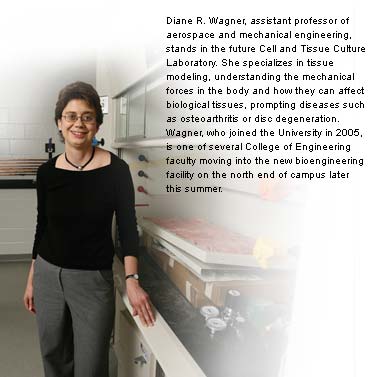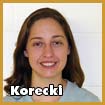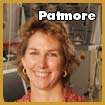 Fund-raisers leading
a building campaign for a new hospital, school, or church often say “It’s
not about a building.” They stress that the structure is simply
a tool to increase the performance and impact of the health care,
education and outreach, or religious activities performed within
its walls. But sometimes it is about a building. Sometimes a building
is the catalyst that sparks a rise to excellence, affecting a neighborhood,
a community, or a world. Fund-raisers leading
a building campaign for a new hospital, school, or church often say “It’s
not about a building.” They stress that the structure is simply
a tool to increase the performance and impact of the health care,
education and outreach, or religious activities performed within
its walls. But sometimes it is about a building. Sometimes a building
is the catalyst that sparks a rise to excellence, affecting a neighborhood,
a community, or a world.
In July 2006 five faculty from the Department
of Aerospace and Mechanical Engineering, one from the Department
of Chemical and Biomolecular Engineering, and their graduate students
and postdoctoral fellows will move from laboratories in Fitzpatrick
Hall to a 25,000-sq.-ft. state-of-the-art facility dedicated to multidisciplinary
research related to biomedical engineering applications.
Located on
the north side of campus next to the Hessert Laboratory for Aerospace
Research, the new building is visible evidence of the commitment
the University has made to biomedical research. “This
is not a me-too program or facility,” says Glen
L. Niebur, associate
professor of aerospace and mechanical engineering. “Although
Notre Dame began biomedical research later than many universities,
we have been very successful in teaming with other institutions, with
medical schools, and with a variety of industry partners nationwide,
including several major orthopedic manufacturers located in Warsaw,
Indiana.“
Lack of a medical school on campus has not affected
the development of the bioengineering program or the building, which
houses laboratories for nano-mechanical characterization, biomaterials
processing and characterization, cell and tissue culture, and tissue
engineering. A tribology laboratory, tissue mechanics lab, manufacturing
area, biomedical imaging lab, and histology and specimen preparation
area are also part of the new facility.
“Moving into a new building is always exciting, particularly
since we [the faculty moving into the facility] were able to work very
closely with the architects to design cutting-edge research space,“ says
Timothy C. Ovaert, professor of aerospace and mechanical engineering.
A key benefit of the new building, according to Ovaert, will be the
synergistic environment created by placing faculty and students who
share common interests together. “We
will be able to focus more on research and interaction with other groups, instead
of logistics.”
Ryan K. Roeder, assistant professor of aerospace
and mechanical engineering, is looking forward to the new space for a number
of reasons. “As
flexible as the space in Fitzpatrick Hall has been, it was not designed
for biomaterials processing or cell and tissue culture,” he says. “I
am also looking forward to having all of my graduate students in the
same space and being able to work closely with them and with other
faculty.” For the past three years Roeder has been partially
utilizing the lab space of JoEllen Welsh, professor
of biological sciences. “Dr.
Welsh has been very generous in allowing us to do all of our cell culture
in her lab space, which puts an added burden on those facilities,” says
Roeder.
Because most of the faculty who will be occupying the new building
hold degrees in more traditional engineering disciplines, questions
they often field include “What can engineers contribute to a
biomedical revolution?” Engineers play a huge role in biomedical
engineering. Combining the traditional strengths of engineers — a
knowledge of materials and mechanical systems, experience in the design
and control of systems, and expertise in materials processing — with
the strengths of biologists and surgeons can impact society. It’s
happening at Notre Dame.
For example, Steven R. Schmid, associate professor
of aerospace and mechanical engineering, and James
J. Mason, formerly
a faculty member and now a researcher at Zimmer, Inc., worked with
the Warsaw, Indiana, based company — a leader in the design,
manufacture, and distribution of orthopedic implants and fracture management
products — to
produce devices that could be used in minimally invasive surgical procedures.
Together, the team pioneered a hip fracture implant featuring curable,
metallic and polymer components that allow for a 25mm surgical incision
instead of the traditional 300mm incision. The new implant and replacement
procedure causes less trauma and promotes a shorter hospital stay and
faster rehabilitation process. Zimmer began clinical trials of the
device in February 2005. With more than 350,000 hip fractures occurring
in the U.S. annually, and approximately four percent of the patients
who undergo hip fracture repair surgery dying during the initial hospital
stay and another 40 percent needing long-term care, the potential impact
is huge.
Similar projects on the horizon for Notre Dame researchers
include a mechanically stable blood substitute, a bioartificial liver
assist device, the development of synthetic bone substitutes, and studies
of microdamage in bone (in relation to osteoporosis and osteoarthritis).
In
addition, the Ernestine Raclin and O.C. Carmichael Jr. Hall, which
houses the Indiana University School of Medicine-South Bend and the
W.M. Keck Center for Transgene Research, was opened in 2005, expanding
collaborative opportunities for engineering faculty.
Much has been accomplished
to date, but much more will be accomplished as faculty continue to
explore the intersection of engineering, biology, and medicine. “Our efforts, which mesh so well with the Catholic
mission of the University,” says Schmid, “will impact the
quality of life as we know it ... in very tangible and direct ways.”
For more information about bioengineering at Notre Dame, visit http://www.nd.edu/~amebio.
|
 |
 |
 |
 |
 |
Even though the
Notre Dame program in bioengineering is relatively young, many
graduate and undergraduate students who have matriculated from
the Department of Aerospace and Mechanical Engineering are already
contributing to the field of biomedical engineering. They include:
In
2006 Brent S. Mitchell received
a master’s degree in mechanical
engineering with a concentration in biomechanics and biomaterials
from Notre Dame. Today he is an associate research engineer at
Osteotech, a leader in the processing of human bone and connective
tissue for transplantation, as well as biological device systems
for musculoskeletal surgery.
As an undergraduate Casey Korecki worked
in the Tissue Mechanics Laboratory studying the effects of vitamin
D on the mechanical properties of bone growth and strength during
gestation. After receiving her bachelor’s degree in mechanical
engineering in 2003, she entered graduate school at the University
of Vermont, where she is a doctoral candidate in the Department
of Mechanical Engineering.
Jules VanDerSarl received a master’s
degree in mechanical engineering from the University in 2004;
today he is pursuing a doctorate at Stanford University.
Alejandro
Espinoza, who received both a master’s (2003) and
Ph.D. (2005) from the University is a postdoctoral research fellow
in the McKay Orthopaedic Research Laboratory at the University
of Pennsylvania.
The cellular therapies development manager for
Biomet Biologics, Inc., a division of Biomet, Inc., Jim
McKale is responsible for establishing
partnerships with surgeons, research institutes, and corporations;
reviewing research protocols for laboratory, animal, and clinical
studies; obtaining regulatory clearance for products through
the FDA; evaluating intellectual property; and overseeing product
development from concept to market. McKale graduated from Notre
Dame with a bachelor’s
degree in mechanical engineering in 1996.
Audrey Patmore, who
received a bachelor’s degree in mechanical
engineering in 1987, is vice president of global product development
at Zimmer Holdings and one of several alumni who work in the Warsaw,
Indiana, based orthopedic company. |
|



